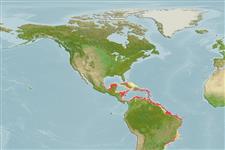分类 / Names
俗名 | 同种异名 | Catalog of Fishes(属, 种) | ITIS | CoL | WoRMS | Cloffa
Teleostei >
Clupeiformes (Herrings)
鯡目 (Herrings) >
Engraulidae (Anchovies)
鯷科 (Anchovies) > Engraulinae
Etymology: Cetengraulis: Greek, ketos = a marine monster, whale + Greek, eggraulis, -eos = anchovy (Ref. 45335).
More on author: Cuvier.
Environment: milieu / climate zone / depth range / distribution range
生态学
海洋; 半咸淡水; 深度上下限 10 - ? m. 熱帶; 23°N - 28°S, 98°W - 32°W (Ref. 189)
Western Atlantic: in the Antilles, from Cuba southward; Costa Rica south and east to Colombia and Venezuela, Trinidad south to Itapema, Santa Catarina, Brazil.
西大西洋: 在安地列斯群島中, 從古巴南方; 哥斯大黎加向南且向東至哥倫比亞與委內瑞拉 , 千里達南至 Itapema ,巴西聖保羅。
Length at first maturity / 大小 / 重量 / 年龄
Maturity: Lm 13.7 range ? - ? cm
Max length : 20.5 cm TL 雄鱼/尚未辨别雌雄; (Ref. 125970); common length : 15.0 cm TL 雄鱼/尚未辨别雌雄; (Ref. 5217); 最大体重: 140.58 g (Ref. 125970)
背棘 (总数) : 0; 臀棘: 0; 臀鳍软条: 18 - 24. Head large and deep. Snout short and pointed, about 2/3 eye diameter; maxilla moderate, tip blunt, just failing to reach lower jaw articulation; fine and numerous lower gill rakers, increasing in large fishes; no gill rakers on posterior face of third epibranchial. Branchiostegal rays 8, long and slender; branchiostegal membrane broad. Silver stripe disappearing at about 10 cm SL (Ref. 189). Dusky dots on upper surface of head and snout, series of large black dots along base of anal (Ref. 37032).
头部大的且深。 吻短与尖的, 大约 2/3 眼直径; 颚骨中等的, 顶端钝的, 正好失败达到下颌关节; 细且多下鳃耙, 增加较大时鱼; 没有在第三个上鳃骨的后面上的鳃耙。 鳃条骨 8, 长且细的; 鳃盖薄膜宽的。 银色的斑纹于大约 10 公分 SL 消失.(参考文献 189) 在头部与吻的上表皮上的暗色的点 , 成列的大黑色点沿着臀鳍基底。 (参考文献 37032)
Occurs inshore and forms quite large schools. Enters brackish waters of lagoons and estuaries and can tolerate salinities of 10.32-31 ppt (Santa Cruz Canal, Pernambuco, Brazil). A filter-feeder presumably on both phytoplankton and zooplankton. Spawns off the Araya Peninsula, Venezuela from October to January, with a distinct peak in mid-November. Eggs are oval, spawned at 0230-0500 hours along shoreline out to about 1.5 km and hatching at about 20-24 hours later.
生活于近海而且相当形成大群鱼群。 进入泻湖与河口的半咸淡水域而且能容忍 10.32-31个 ppt 的盐度.(圣克鲁兹管, 巴西的贝宁博古) 一个滤食动物可能在浮游植物和浮游动物上。 从十月到一月产卵在委内瑞拉的 Araya 半岛外, 在十一月中具有一个明显的高峰。 卵是椭圆形的, 产卵在 02300500 小时的沿着在外的海岸线到大约 1.5 公里与孵化于大约 20-24 小时之后。
Life cycle and mating behavior
成熟度 | 繁殖 | 产卵场 | 卵 | 孕卵数 | 仔鱼
西大西洋: 在安地列斯群島中, 從古巴南方; 哥斯大黎加向南且向東至哥倫比亞與委內瑞拉 , 千里達南至 Itapema ,巴西聖保羅。
Whitehead, P.J.P., G.J. Nelson and T. Wongratana, 1988. FAO Species Catalogue. Vol. 7. Clupeoid fishes of the world (Suborder Clupeoidei). An annotated and illustrated catalogue of the herrings, sardines, pilchards, sprats, shads, anchovies and wolf-herrings. FAO Fish. Synop. 125(7/2):305-579. Rome: FAO. (Ref. 189)
世界自然保护联盟红皮书 (Ref. 130435: Version 2024-1)
人类利用
渔业: 低经济; 诱饵: usually
工具
特别资料
下载 XML
网络资源
Estimates based on models
Preferred temperature (Ref.
123201): 24.4 - 28, mean 27.4 °C (based on 76 cells).
Phylogenetic diversity index (Ref.
82804): PD
50 = 0.7500 [Uniqueness, from 0.5 = low to 2.0 = high].
Bayesian length-weight: a=0.00490 (0.00386 - 0.00621), b=3.24 (3.17 - 3.31), in cm total length, based on LWR estimates for this species (Ref.
93245).
营养阶层 (Ref.
69278): 2.1 ±0.07 se; based on food items.
回复力 (Ref.
120179): 中等的, 族群倍增时间最少 1.4 - 4.4年 (K=0.13-0.22; Fec=8,189 (batch fecundity)).
Prior r = 0.55, 95% CL = 0.37 - 0.83, Based on 3 data-limited stock assessments.
Fishing Vulnerability (Ref.
59153): Moderate vulnerability (44 of 100).
Climate Vulnerability (Ref.
125649): Moderate to high vulnerability (50 of 100).
Nutrients (Ref.
124155): Calcium = 189 [109, 487] mg/100g; Iron = 1.52 [0.77, 2.95] mg/100g; Protein = 18.3 [16.7, 19.9] %; Omega3 = 0.389 [0.196, 0.833] g/100g; Selenium = 31.4 [14.3, 73.9] μg/100g; VitaminA = 24.9 [5.4, 82.9] μg/100g; Zinc = 2.65 [1.77, 4.20] mg/100g (wet weight);
